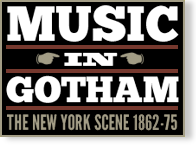Mason and Thomas Chamber Music Soiree: 2nd
Event Information
Venue(s):
Steinway Hall
Price: $1.50
Event Type:
Chamber (includes Solo)
Record Information
Status:
Published
Last Updated:
21 January 2016
Performance Date(s) and Time(s)
07 Mar 1867, 8:00 PMPerformers and/or Works Performed
Citations
“Music. The third soirée of Chamber Music will occur March 21, at Steinway’s, when Beethoven, Mozart, and Schumann will be represented by a quartet, a quintet, and a Sonata (for piano and violin, A minor, op. 106.) ‘Fit audience but few’ attend these concerts; so much the more reason, therefore, to praise them. Their executants are the well-read and able [?] William Mason, the pianist; Mosenthal, the violoncellist; and Thomas, Bergner, and Matzka, the violinists. We have no quintet like them—their instrumental autograph is con amore; nothing they ever do is ill-done. For many classic novelties we owe them thanks; and one of these, produced at the last soirée, deserves particular note. It was a trio in E flat, for piano, violin, and violoncello, which none other than Schubert could have written. Four parts, three of which are allegro, make up the story of this genuine, genial tone-poem. The allegros have a pleasant distinctness and freshness, and relate their thought with a perpetual and penetrative delicacy. We prefer the first two movements—Allegro and andante—as being the larger in conception, though the remainder of the work is a unique study—never inferior in ideality, admit as we may that the last allegro is less interesting than the first. Here, however, is a movement that charms us at all points with a lyrical quality never absent from the genius of Schubert—a movement with the heartiness and freedom of Mozart. Then follows the andante, broad and deep, and tender as it can be—the heart and passion of the poem—wherein we can never for a moment miss the pervading, dreaming Schubert, whose appreciative passion mourns through Ossian and The Doppelganger, whose songs were epical and whose lyre was symphonic. Other masters may be admired and revered; but Schubert, whose art was deep as his life was short—is fitted by his universal sympathies to be especially beloved. The trio was very capably played—the violoncello part exceedingly gracious in tone.”
The arrangement of the program is a good one.…The performed works have been played a lot here; even Schumann’s “Novelletten”, opus 21, is no stranger even to amateurs. Teachers prefer to use Schumann’s pieces to Chopin’s. Mason played both Schumann pieces very effectively with his magical touch of the keys. All the other works in the program were given excellent justice by the performers.

